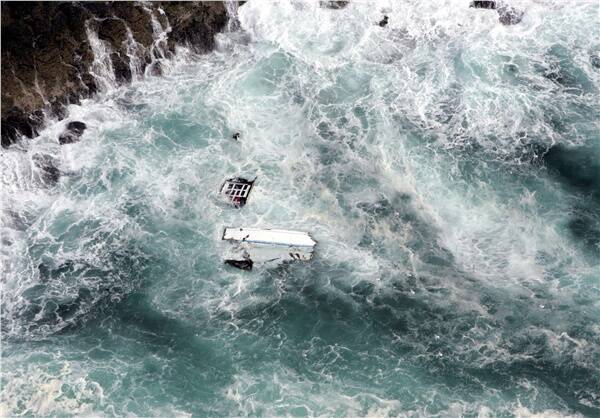Illawarra rescue paramedic Peter Daniel has told how he winched 15 people to safety after their yacht was destroyed on rocks off Flinders Islet.Mr Daniel said the patients were huddled at the centre of the islet, also known as Toothbrush Island, and were winched one at a time into the helicopter before being transported to shore."There wasn't any panic from what we could see. They'd made themselves safe in the middle of the island," he said.
Port Kembla yacht crash: two dead, 16 rescued SLIDESHOW: Two killed in yacht race crashIllawarra Ambulance acting assistant division manager Norm Rees said emergency services responded to the call of a yachting accident off Flinders Islet at 3.06am.The initial call came through the yacht's EPIRB (Emergency Position Indicating Radio Beacon) distress beacon.Eight ambulances and the Rescue 26 helicopter were sent to the scene and a makeshift triage established at the end of Foreshore Rd, Port Kembla.Mr Rees said that there were 18 patients, two of whom were deceased.Mr Daniel said the rescue helicopter initially responded to an alert of people in the water and the crew conducted a search, however visibility was hampered by a sea mist."We did quite an extensive search of the water around the island. Visibility was poor. We were not getting good vision using the night sun and the hand-held lights," he said."There were a number of yachts doing search patterns around the island."At a certain stage more information was coming to hand that people had been found by the vessels, so then we concentrated on getting the people off the island."We first picked them up in our search light and their reflective yachting gear made them highly visible. We knew there was a large number from the glow that we were getting back. They were all huddled together."The 15 on the islet had been in the water and were showing signs of hypothermia. They were certainly in a state of shock but they were basically well."Mr Daniel and the helicopter crew conducted a series of winches, first rescuing four people then delivering them to shore.The first to be winched was a 14-year-old boy who was suffering burns to his hands.Six more people were winched before the helicopter was forced to refuel and return for the remaining people."I winched down on a cable ... I have a strop which goes over the person. We lifted them into the aircraft one at a time,'' he said."Once they were winched, they were taken to land, put down in a car park that was a temporary landing site."Mr Rees said a doctor was on the scene to meet patients as they arrived."We had the doctor there, they were triaged and sent off in our vehicles - all to Wollongong Hospital."Because they came in small waves, we had eight ambulances transporting them one or two at a time. The hospital was able to cope with them and we'd given them an indication that it was happening."Mr Rees said the most serious injury was the burn suffered by the child."All the rest were fairly minor - hypothermia, cuts and abrasions. All treatable," he said.By 5.50am all patients had been transported safely to shore.A police launch rescued one person who was suffering unspecified injuries, while also retrieving the bodies of Sally Gordon, 47, and skipper Andrew Short, 48, who were killed in the accident.Mr Daniel said there was no chance of the helicopter landing on the islet, which measures about 300m long and 150m wide and is located 2.5km from the mainland."We wouldn't have attempted landing on the island, it was just too rough. The rocks are very uneven,'' he said."There was a large sea swell. The water was very choppy. It was all over the place and there was a sea mist that made visibility very poor."Mr Rees said he believed the yacht ran into the northern side of Flinders Islet.Mr Daniel added: "The yacht's an absolute wreck and is totally torn apart ... I believe it's come aground, the mast has broken and they've scrambled into the water and on to rocks. But the conditions were pretty severe where the actual yacht has hit. There was a lot of turbulent white water.''Mr Daniel said the rescue helicopter's crew of four included a pilot, air crewman winch operator, doctor and a rescue paramedic. "The air crew did a great job, they were very precise and it was very easy. We trained for that. The wind was calm and the aircraft got in nice and low which meant the winching was quick and effective," he said.Mr Rees described the scale of the operation as major, although his team regularly trained for "multi-patient" incidents.He said it was the first yachting accident that he was aware of involving the Five Islands area.


